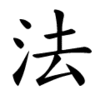法
| ||||||||
Translingual
| Stroke order | |||
|---|---|---|---|
| Stroke order | |||
|---|---|---|---|
 | |||
Han character
法 (radical 85, 水+5, 8 strokes, cangjie input 水土戈 (EGI), four-corner 34131, composition ⿰氵去)
Related characters
- 灋 (Variant traditional form of 法)
References
- KangXi: page 616, character 11
- Dai Kanwa Jiten: character 17290
- Dae Jaweon: page 1010, character 2
- Hanyu Da Zidian: volume 3, page 1579, character 4
- Unihan data for U+6CD5
Chinese
| simp. and trad. |
法 | |
|---|---|---|
| variant forms | 㳒 灋 𢌇 佱 𣳴 | |

Glyph origin
| Historical forms of the character 法 | |
|---|---|
| Western Zhou | Shuowen Jiezi (compiled in Han) |
| Bronze inscriptions | Small seal script |
 |
 |
| Characters in the same phonetic series (法) (Zhengzhang, 2003) | |
|---|---|
| Old Chinese | |
| 法 | *pqab |
| 灋 | *pqab |
Simplified from earlier 灋, which was originally used to represent 廢 (OC *pads, “to cast aside; to abrogate”).
Etymology
Sino-Tibetan. Cognate with Tibetan བབས (babs, “shape, form, appearance”), དབྱིབས (dbyibs, “shape, form, figure”). Possibly cognate with 凡 (OC *bom, “all, general, every; pattern, general rule”); see there for more.
Pronunciation
Definitions
法
Usage notes
- Xiandai Hanyu Guifan Cidian (《现代汉语规范词典》) proscribes the use of the pronunciations fā, fá and fà.
Compounds
|
|
|
Descendants
Others:
- → Proto-Tai
- Lao: ແບບ (bǣp, “form; model, standard, example; method; style, manner; brand, type”)
- Thai: แบบ (bɛ̀ɛp, “kind; design, pattern; style; type; model”)
- → Khmer: បែប (baep, “kind, sort, model, type; style, form, shape; aspect; method, way, situation, condition”)
- → Vietnamese: phép (“rule, custom, usage, method; permission, authorisation; magical power”)
Japanese
Readings
Compounds
- 永字八法 (eiji happō, “the Eight Principles of Yong”)
- 法号 (hōgō, “a dharma name”)
- 法案 (hōan)
- 法印 (hōin)
- 法衣 (hōe), 法衣 (hōi)
- 法医学 (hōigaku)
- 法王 (hōō)
- 法皇 (hōō)
- 法外 (hōgai)
- 法学 (hōgaku)
- 法規 (hōki)
- 法事 (hōji)
- 法術 (hōjutsu)
- 法人 (hōjin)
- 法則 (hōsoku)
- 法定 (hōtei)
Etymology 1
| Kanji in this term |
|---|
| 法 |
| ほう Grade: 4 |
| on’yomi |
From Middle Chinese 法 (MC pɨɐp̚). Originally, the kan'on was はふ (fafu), and the goon was ほふ (fofu), although both became ほう (hō) in modern Japanese. It is suggested that the kan'on was used in the general senses, while the goon was used in Buddhist contexts.
Noun
Pronunciation
References
- 2002, Ineko Kondō; Fumi Takano; Mary E Althaus; et. al., Shogakukan Progressive Japanese-English Dictionary, Third Edition, Tokyo: Shōgakukan, →ISBN.
Korean
Hanja
法 • (beop) (hangeul 법, revised beop, McCune–Reischauer pŏp, Yale pep)
- This term needs a translation to English. Please help out and add a translation, then remove the text
{{rfdef}}.